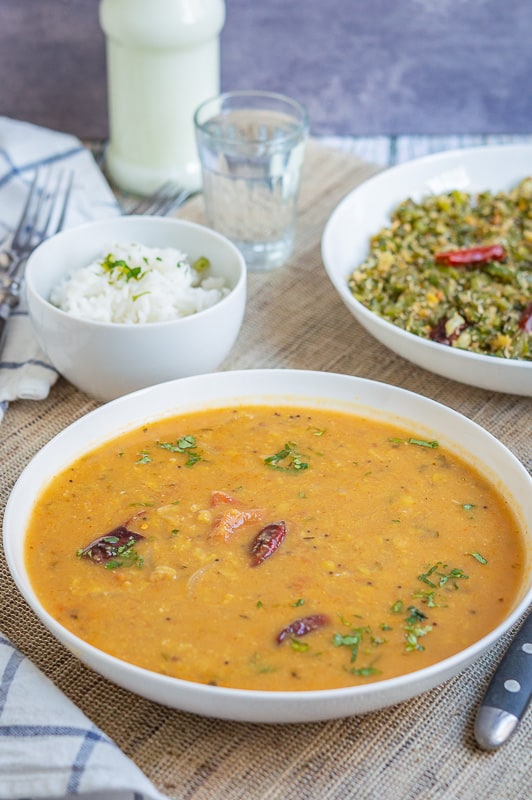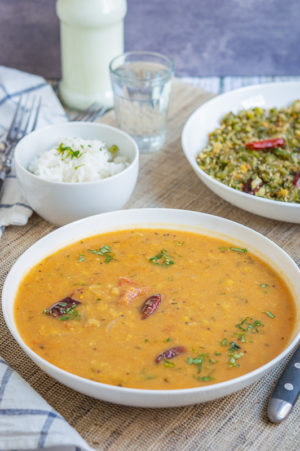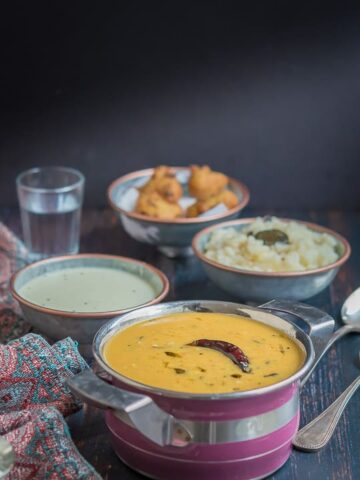Arachuvitta Sambar - Vegetables cooked in a tamarind extract and thickened with lentils. This variation of sambar is a tamil brahmin recipe. One that is made regularly at homes as an accompaniment to rice.

"Anyone who has never made a mistake has never tried anything new"
- Albert Einstein
Wondering the origin of Sambar ?
Sometimes, things have to go wrong before they go right. It is a very apt quote for those pursuing their culinary dreams. Accidents and mistakes are unwelcomed in most fields but in cooking it is embraced. Why? Read ahead.
The ever loving cheese, potato chips, delicious chocolate chip studded cookies, ice popsicles were all made by distracted and daydreaming cooks. The iconic dish of South India, the lip-smacking dip for idly, dosa, vada also fall under this category. As mentioned in this post, Sambar is the result of the trials and experiments of the Maratha King, Shauji. His love for Amti (A Maratha dish) was the turning point of in the invention of sambar. When he invaded Tanjavur, he missed amti a lot. As kokum was not available in Tamil Nadu, he could not make his favourite dish.
Being a great cook himself, he tried to experiment with the local ingredients to create his favourite dish. The final dish, though it was not even close to amti, was praised by everyone and became a separate dish in itself. If not for his love for Amti, the whole world would have missed this delicacy - the south indian sambar.
What is a sambar ?
Sambar is a kind of stew in which the vegetables are cooked in tamarind extract and then thickened with toor dal. It is a part of south indian main course, an everyday meal.
Unlike in the west where rice comes as a side, in India, it is the main meal. Just like creamy gravies accompany the exotic flatbreads in the North, we have our own specialties. Rasam, sambar and kootu are the main course. We mix these with white rice and have it as rasam sadam (sadam is rice in Tamil), sambar sadam etc.
Preparation of sambar can be broken down into two steps.
- Cooking vegetables in tamarind extract. Move on to the second step once the vegetables get cooked and the raw smell of the tamarind goes off.
- Then you need to thicken the gravy. It can be done in two ways. If it is a plain sambar or parupu sambar, dal along with a teaspoon of rice flour is used to thicken. For arachuvitta sambar (this post), the thickening agent is a home made masala and ground coconut paste along with it.

Vegetables to be used in a Sambar:
For arachuvitta sambar it is mostly drumsticks, radish, and onion, pearl onion (chinna vengayam) are the veggies that impart the most flavour. You can also use chayote (chow chow), green pumpkin (vellai poosanikai) or carrots.
Things to keep in mind while making dal
- Cooking of dal is important. If the dal is not mashed properly, then the tamarind extract and lentils will be separate and you wont get a proper stew. Generally, rice and dal are kept together in a pressure cooker to save time. Sometimes the tuvar dahl might not get cooked easily. The water you use or the quality of the dal may affect its cooking time. Soak the dal in water for half an hour and then cook. For a sambhar, the lentils must be fully cooked and easily mash when you whisk it.
- Second, the veggies may take a longer time to cook in tamarind water. So if that is the case, half cook the veggies in plain water after the tempering and then add the tamarind extract. This really helps for hard veggies like drumsticks and radish. Please refer to my notes below for complete tips and suggestions that might help you while making sambhar.
- If you feel it is less spicy, then temper few dry red chillies in a teaspoon of oil and add it to sambar.

Arachuvitta Sambar – Vegetables cooked in a tamarind extract and thickened with lentils. This variation of sambar is a tamil brahmin recipe that is made regularly at homes.
- 1 cup of cubed carrots, radish or whole pearl onions refer notes
- ½ cup toor dal | split pigeon peas
- ½ teaspoon turmeric powder
- 2 tablespoon oil or ghee
- 1 teaspoon mustard seeds
- 2 to 3 dry red chillies broken in half
- 4 to 5 fenugreek seeds refer notes
- 4 to 5 curry leaves
- 18 grams tamarind pulp or 1.5 tablespoon tamarind paste mixed in 2.5 cups water refer notes
- 2.5 to 3 cups water, divided
- Salt to taste
- 1 teaspoon sambar powder (optional)
- 3 tablespoon fresh or frozen grated coconut or 2 tablespoon unsweetened dessicated coconut
- 1 tablespoon channa dal | split bengal gram refer notes
- 1.5 tablespoons coriander seeds
- 2 to 3 dry red chillies
- ⅛ teaspoon fenugreek seeds (methi seeds)
Add water enough to immerse the dal and pressure cook the dal with turmeric powder and keep aside. It might take about 10 to 12 minutes on medium high flame. The dal should be soft and mushy. (4)
Roast the ingredients (except the coconut) mentioned under to grind. Grind the coconut and spice mix into a smooth paste by adding little water.
- Heat oil in a Kadai | Pan over medium high heat. Once the oil shimmers, add the mustard seeds and let it splutter. Then add the curry leaves, red chillies, fenugreek seeds and fry for a second.
- Then add all the veggies that you are adding and stir them for a minute. (5)
Then add the tamarind extract and about a cup of water. Add salt, sambar powder and allow it to boil for about 12-15 minutes. Keep the heat on medium or medium high. (6)
After about 15 minutes, the liquid would have reduced and the raw smell of the tamarind would have gone. If you feel the raw smell is still there, boil it for some more time.
Now add the mashed dal, coconut paste and some ½ Cup water. Bring it to a full boil and turn off the stove. Garnish it with coriander leaves.
It will slightly thicken upon cooling. Add more warm water if needed. Serve it with rice.
- Veggies like drumsticks, onions, white radish, white pumpkin, yellow pumpkin, carrots, can be added. Chop them in chunks. It has to hold its shape while cooking.
- Do not overdo the fenugreek seeds. It will be bitter to bite. So, just a little goes a long way.
- Measuring tamarind pulp is really difficult. 18 grams of tamarind pulp is about a tablespoon of tightly packed pulp. This is an approximate.
- Please refer to this post to see how tamarind quality affects the gravy. Refer to the notes section in that post.
- Generally, rice and dal are kept together in a pressure cooker to save time. Sometimes the toor dal might not get cooked easily. The water you use or the quality of the dal may affect its cooking time. Soak the dal in water for half an hour and then cook. For a sambar, the dal must be really cooked and mashed.
- Sambar should be thick but in a pourable consistency. So do not add more water and make it runny. The best I could come up with for those who have not had it, it is very close to a thick soup's consistency.
- The veggies, take a longer time to cook in tamarind water. So if that is the case, half cook the veggies in plain water after the tempering and then add the tamarind extract. This really helps for hard veggies like Drumsticks and Radish.





Meghna says
A hearty bowl of Sambhar with an informative history . Thanks for the lovely share, I am going to try it out soon!
code2cook says
sambhar has come out great. Perfect thickness, color a great dish with idli or dosa.
Lathiya says
Though I make sambar very week, I didn't know the story behind it...This coconut based sambar is my favorite..I love this more the next day..sambar looks delicious
sapana says
I am yet to make this Tamil Brahmin version of the sambhar. Bookmarking your recipe to try soon.
Jagruti Dhanecha says
What an informative post, never knew about the history of sambhar. One of my favourite dish and yours looks incredibly tasty.
Ritu Tangri says
Such an elaborate write up. You have explained about sambar so well. Thanks for sharing
themadscientiststskitchen says
Nisha sambhar is delicious but what is that green vegetable behind?? Love it too! Is the recipe on the blog?
Freda @ Aromatic essence says
Lovely bowl of sambar. Loved reading the origin of sambar, didn't know about it until now. Thanks for sharing this little piece of info 🙂
Sandhya says
Freshly made masala must make this sambhar superb! I liked reading the background story about Sambar as well.
Poonam Bachhav says
Loved reading the invention of Sambar and the photographs speak so much about the dish..awesome spread !
Shobha Keshwani says
I love this freshly made masala sambar.. Tastes heavenly.
Malini says
Yummy Sambhar recipe. With Kootu, Rasam, Poriyal and rice. It's a heavenly lunch. I loved your notes also. Thanks for sharing 🙂
Pavani N says
Awesome post Nisha. Loved reading every bit of info about Sambar. Thanks for sharing.
Sambar looks creamy & delicious.